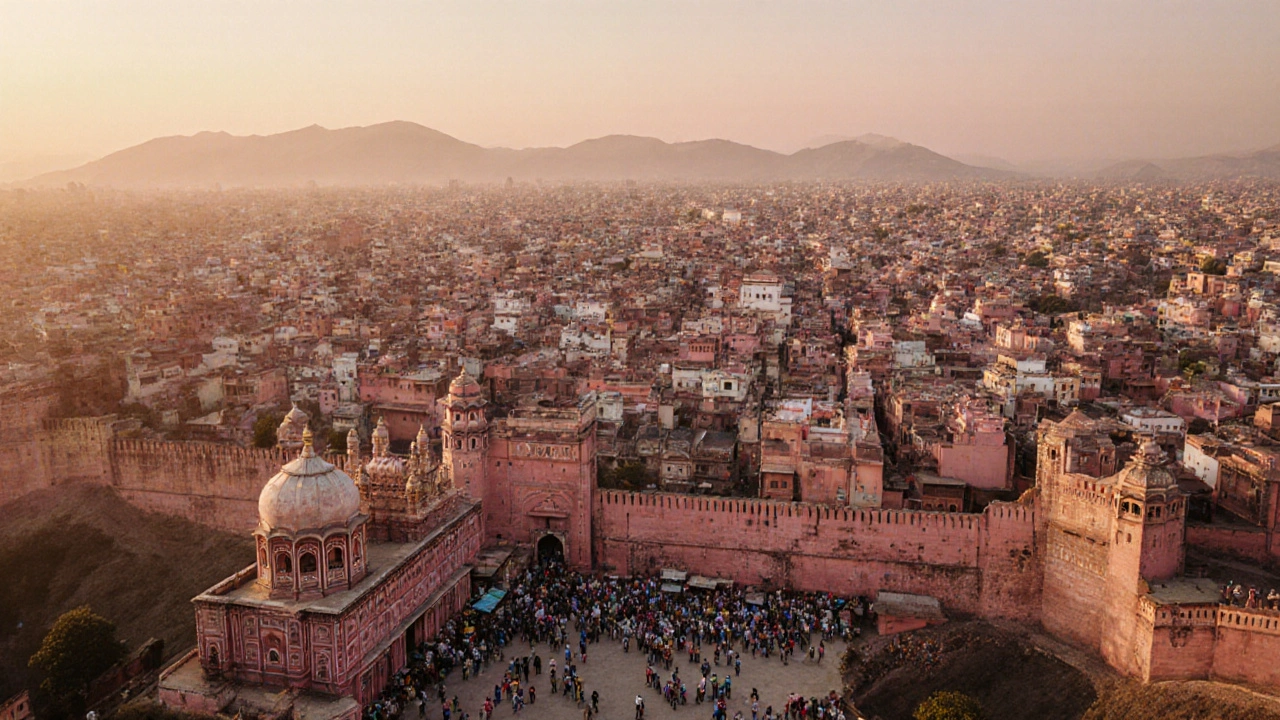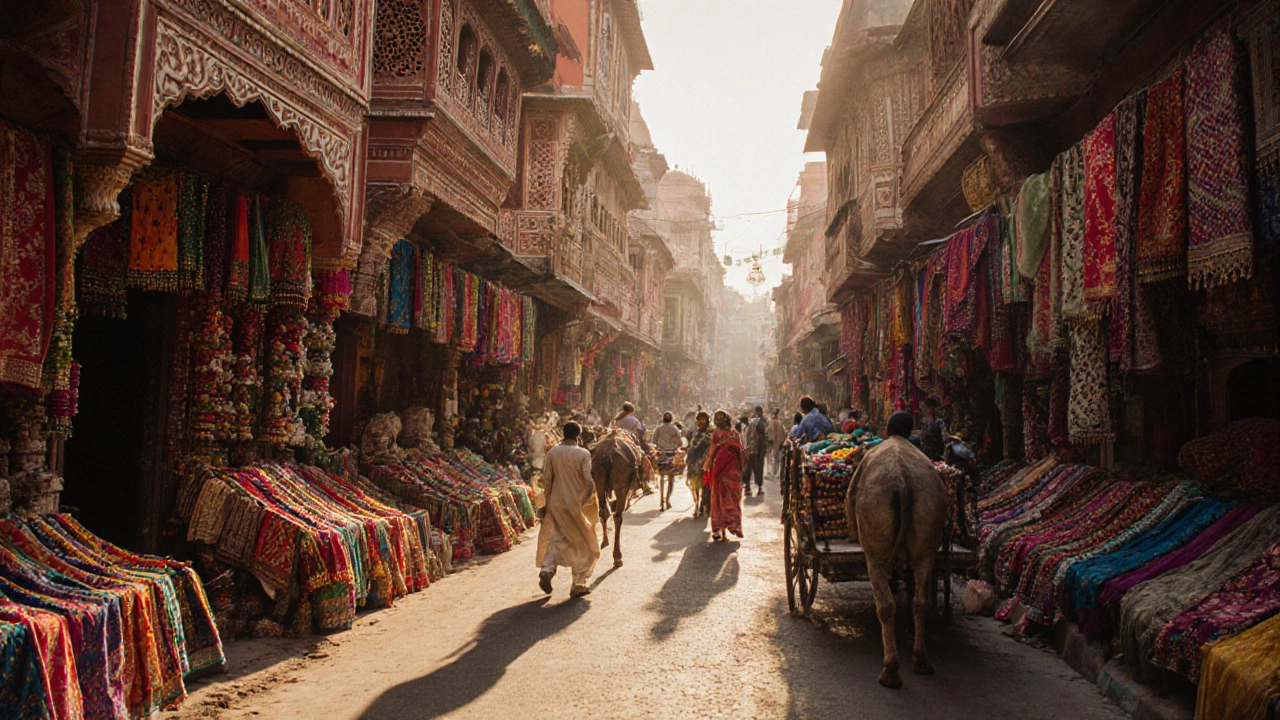Which City Is Known as the Heritage City of India?
 Nov, 17 2025
Nov, 17 2025
When people ask which city is known as the heritage city of India, they’re usually thinking of one place that stands out above all others - Jaipur. Known as the Pink City, Jaipur isn’t just painted in soft rose tones; it’s built on centuries of royal tradition, urban planning, and cultural preservation. It’s the only city in India officially recognized as a UNESCO World Heritage Site in its entirety, not just for one monument, but for its entire walled city layout, streets, palaces, and markets. That’s rare. Most heritage sites protect a single temple or fort. Jaipur protects a whole living city.
Why Jaipur Earned the Title
Jaipur was founded in 1727 by Maharaja Sawai Jai Singh II, a ruler who wasn’t just a king - he was an astronomer, mathematician, and city planner. He designed Jaipur using principles from ancient Indian architecture and Vastu Shastra, blending symmetry, grid patterns, and functional zoning. The city was divided into nine blocks, each meant for a specific purpose: royal palaces, markets, temples, and residential areas. This level of foresight was unheard of in 18th-century India.
What makes it truly unique is that Jaipur wasn’t built on ruins. It was planned from scratch, using brick and stone, and designed to accommodate growth. Even today, the old city still functions as it did 300 years ago - traders sell textiles in Johari Bazaar, potters shape clay in Kishanpole Bazaar, and families live in havelis with carved stone jharokhas. The city didn’t become a museum. It stayed alive.
What Makes It a Heritage Site - Not Just Pretty Buildings
UNESCO didn’t list Jaipur because it’s colorful. They listed it because it represents a unique fusion of Hindu, Mughal, and Rajasthani architecture with scientific urban design. The Jantar Mantar observatory alone contains 19 architectural instruments built to measure time, track stars, and predict eclipses - some still accurate to within seconds. The City Palace complex blends Mughal domes with Rajput courtyards. The Hawa Mahal, with its 953 small windows, wasn’t just for beauty - it allowed royal women to observe street festivals without being seen, while catching cool breezes in a hot climate.
Compare this to other cities often called heritage cities. Agra has the Taj Mahal - a single masterpiece. Varanasi has ancient ghats and temples - but its layout evolved organically over 3,000 years, without central planning. Delhi has multiple heritage zones - but they’re scattered, disconnected, and often overshadowed by modern sprawl. Jaipur is different. It’s a single, intact, walkable heritage zone where every street, gate, and water tank tells a story.
Other Cities That Sometimes Get Called Heritage Cities
People often confuse Jaipur with other historic Indian cities. Here’s how they stack up:
| City | UNESCO Status | Heritage Scope | Living City? | Key Heritage Feature |
|---|---|---|---|---|
| Jaipur | Yes - entire walled city (2019) | Full urban fabric | Yes - 1.5 million residents | Planned grid, pink architecture, Jantar Mantar |
| Agra | Yes - Taj Mahal and Agra Fort only | Two monuments | Partially | Taj Mahal (1653) |
| Varanasi | No - on UNESCO’s tentative list | Religious sites only | Yes - oldest continuously inhabited city | Ghats along Ganges |
| Delhi | Yes - but only Red Fort, Qutub Minar, Humayun’s Tomb | Dispersed sites | Partially | Mughal architecture |
| Khajuraho | Yes - temple group only | 20 temples | No - small town | Sculpted erotic temples (950-1050 CE) |
Jaipur is the only one where the entire city - its walls, gates, streets, water systems, and markets - is protected as a single heritage unit. Other places have monuments. Jaipur has a system.

What You’ll See If You Visit
Walk through the old city gates - Tripolia, Suraj Pol, or Chandpole - and you’re stepping into a living timeline. The street names haven’t changed. The bazaars still sell the same things: bandhani textiles, blue pottery, lac bangles, and brassware. You’ll hear the same call of the chaiwallahs, the same clang of metalworkers, the same chants from temples tucked between shops.
At night, the City Palace is lit up, and the sound of classical sitar drifts from a courtyard where a royal descendant still hosts private performances. In the winter months, the Jaipur Literature Festival draws over 200,000 people - writers, poets, and thinkers - to the same palace courtyards where kings once held court.
There’s no glass tower here. No McDonald’s in the old city. The local government enforces strict rules: no new buildings taller than the Hawa Mahal. No plastic bags in the markets. No cars allowed in the inner ring. This isn’t nostalgia - it’s policy.
Why This Matters Beyond Tourism
Jaipur’s heritage isn’t just for postcards. It’s a working model of sustainable urban living. The city’s stepwells, or baoris, were designed to collect monsoon rain and recharge groundwater. Many are still in use. The wide streets and shaded walkways reduce the urban heat island effect. Even the pink paint - originally made from local limestone and lime - helps reflect sunlight and keep buildings cooler.
In a world where cities are growing faster than their infrastructure, Jaipur shows that heritage can be practical. It’s not about freezing history in glass cases. It’s about adapting old wisdom to modern needs. The city proves you don’t have to tear down the past to build the future.

How to Visit Like a Local
If you’re planning a trip, here’s what most tourists miss:
- Visit the Jantar Mantar at sunrise - it’s quiet, the light hits the instruments perfectly, and you’ll see locals using them to tell time.
- Walk the entire inner ring - from Hawa Mahal to Nahargarh Fort - instead of hopping in a tuk-tuk. You’ll see how the city flows.
- Try the local street food: pyaaz kachori, ghewar, and laal maas. Eat where the locals eat - not in hotel restaurants.
- Stay in a restored haveli. Many have been turned into boutique hotels with courtyards, hand-painted walls, and rooftop views.
- Don’t rush. Jaipur rewards slow travel. Sit in a courtyard with chai. Watch the light change on the pink walls. That’s when you feel the heritage.
Jaipur doesn’t shout its history. It whispers it - in the rhythm of footsteps on stone, in the scent of marigolds in temple courtyards, in the way the wind moves through a hundred tiny windows. That’s why it’s not just a city with heritage. It’s the heritage city of India.
Is Jaipur the only heritage city in India?
No, India has many heritage sites, but Jaipur is the only city where the entire walled urban center - including streets, markets, palaces, and water systems - is protected as a single UNESCO World Heritage Site. Other cities like Agra and Delhi have individual monuments listed, but not the full city fabric.
Why is Jaipur called the Pink City?
In 1876, the city was painted pink to welcome Prince Albert of Wales. Pink symbolizes hospitality in Rajasthani culture. The color was made from limestone and lime, and the tradition stuck. Today, the government requires all buildings in the old city to maintain the pink hue.
Can you still live in Jaipur’s heritage zone?
Yes. Over 1.5 million people live in Jaipur’s UNESCO-listed area. They run shops, work in offices, raise families, and attend temples - all within the historic walls. The city is not a museum. It’s a living, breathing urban center where heritage rules protect daily life.
What’s the best time to visit Jaipur?
October to March is ideal. Temperatures are mild (15-28°C), the air is clear, and festivals like Diwali and the Jaipur Literature Festival happen during this time. Summers (April-June) are extremely hot, with temperatures over 40°C.
Is Jaipur safe for solo travelers?
Yes. The old city is well-patrolled, and locals are generally helpful. Stick to main streets after dark, avoid unmarked tuk-tuks, and dress modestly. The city is one of the safest in India for solo travelers, especially compared to larger metros.
Next Steps for Heritage Travelers
If Jaipur sparked your interest, consider exploring other heritage clusters in India. The stepwells of Gujarat, the temple towns of Tamil Nadu, or the Mughal gardens of Kashmir all offer different kinds of heritage experiences. But if you want to see how a city can honor its past while thriving today - Jaipur is the place to start. It’s not just a destination. It’s a lesson.